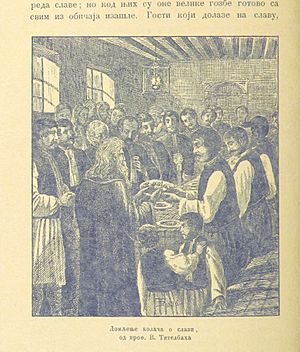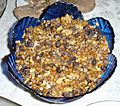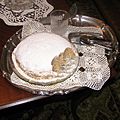Slava facts for kids
Quick facts for kids Slava |
|
|---|---|
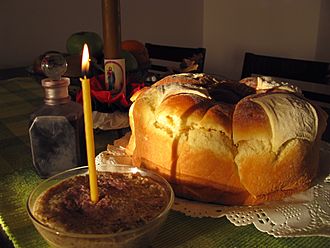
Slava prepared for the veneration of John the Baptist
|
|
| Observed by | Serbian Orthodox Christians |
| Significance | Veneration of the family's patron saint |
| Observances | Church services, family and other social gatherings |
| Date | Lua error in Module:Wikidata at line 132: attempt to index field 'wikibase' (a nil value). |
The Slava (Serbian Cyrillic: слава, lit. 'celebration') is a special tradition for Serbian Orthodox Christians. It's a yearly celebration where a family honors its own patron saint. This celebration happens every year on the saint's special day, called a feast day. In November 2014, the Slava tradition was added to the UNESCO Intangible Cultural Heritage Lists, which means it's recognized as an important part of human culture.
Contents
What is Slava?
The Slava is a yearly family event where people honor their family's patron saint. It's also a big social gathering. The whole family comes together at the home of the family's oldest male member, called the patriarch. Friends often come too, usually without needing an invitation. There's even an old Serbian saying: "One does not invite people on Slava."
How is the Saint Chosen?
The family saint is passed down from father to son. When a woman gets married, she takes on her husband's family saint. Some families honor their saint twice a year. The main celebration day is called Slava, and the second, smaller day is called preslava. Sometimes, if a wife is the last person left from her family, her husband's family might also celebrate her family's patron saint out of respect.
Slava and Serbian Identity
The Slava tradition is a very important part of Serbian identity. A famous saying goes: "Где је слава, ту је Србин" (which means "Where there is a Slava, there is a Serb"). Many Serbs see Slava as their most important and serious feast day. Serbs all over the world, even those living far from Serbia, keep this tradition alive.
Where Else is Slava Celebrated?
Besides modern-day Serbia, Slava is also common in areas where the Serbian medieval state once had influence. However, it's not just Serbs who celebrate similar traditions. You can find similar customs among Montenegrins, Macedonians, and some Catholics in places like Boka Kotorska and Southern Herzegovina. Christians in Northern Albania, and even some Muslims among Gorani and Bosniaks in Bosnia, also have similar practices. A similar tradition is also found in Western Bulgaria and among some Vlachs and Aromanians.
History of Slava
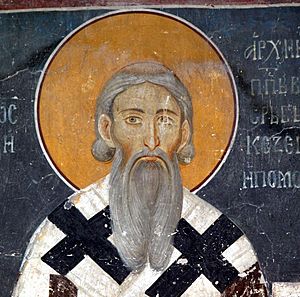
Historians believe that records of Slava among Serbs go back at least to the year 1018.
Early Beginnings
The tradition started in Medieval Serbia. It is linked to Saint Sava, who was the first Archbishop of the Serbs. Some believe that Saint Sava helped shape the Slava tradition. He found a way to combine older Serbian beliefs with Christian teachings. The Slava is seen as a new way of celebrating an old Serbian custom. In the past, people honored an ancestor who protected their family. This ancestor then became a Christian saint, often Saint Nicholas. The old customs became more focused on social gatherings than on many religious ceremonies.
Slava in Modern Times
After World War II, many people moved from farms to cities. Also, during the Communist rule, Serbian Orthodox traditions were not openly supported. This made some parts of the Slava custom more flexible. For example, families often lived far apart. So, sometimes, Slava had to be celebrated in more than one place by different family members.
Even though it was not openly promoted, Slava remained popular during the Communist period. After the Communist rule ended, Serbian Orthodox traditions became popular again, and Slava saw a big comeback. Today, it's seen as a unique Serbian custom. Even people who are not very religious or are atheists often celebrate it. They see it as a family holiday passed down through generations and a way to show their cultural identity.
In November 2014, Slava was officially added to the UNESCO Intangible Cultural Heritage Lists. This shows how important it is. The custom is also helpful for studying family history. It can help trace family connections and where families originally came from.
How Slava is Celebrated
Где је слава, ту је Србин / Gde je slava, tu je Srbin ("Where there is a Slava, there is a Serb")
—Miloš Milojević
Special foods are prepared for the Slava feast. These include the slavski kolač (or simply kolač), which is a special bread. Another important dish is koljivo (or žito). This is made from minced boiled wheat, sweetened, and sometimes mixed with chopped walnuts.
Special Foods and Their Meanings
The top of the kolač bread is decorated with symbols like the Christian cross and a peace dove. The koljivo represents the Resurrection of Christ. It is eaten to remember family members who have passed away.
The rest of the meal depends on whether the celebration falls during a period of fasting. During a fast (called post), the meal will not have meat (except fish or seafood), eggs, or dairy products. If it's not a fasting period (called mrsno), these rules don't apply. So, Slavas are often called posna (fasting) or mrsna (non-fasting). Special sweets are also eaten.
Church Services and Blessings
Families usually go to church services and take Holy Communion on the feast day. After the service, the parish priest traditionally visits the family's home. Or, the family brings the slavski kolač to the church. The priest performs a short service. This includes honoring the patron saint, blessing the kolač and koljivo, and lighting the "slava candle." Sometimes, the priest also blesses the house and holds a small service to remember dead relatives.
Common Slava Dates
Some of the most common feast days for Slava are:
- St. Nicholas (Nikoljdan, December 19)
- St. George (Đurđevdan, May 6)
- St. John the Baptist (Jovanjdan, January 20)
- St. Demetrius (Mitrovdan, November 8)
- St. Michael (Aranđelovdan, November 21)
- St. Sava (Savindan, January 27)
These dates are given according to the Gregorian calendar. The Serbian Orthodox Church actually uses the Julian calendar, so the dates are different on that calendar.
Community Slavas
Many Serbian communities, like villages, cities, organizations, and even companies, also celebrate their own patron saint. For example, the city of Belgrade celebrates the Ascension of Jesus Christ as its patron saint's feast.
Images for kids
-
Church prepared for the celebration of a Slava, Trebinje, Republika Srpska, Bosnia and Herzegovina.


